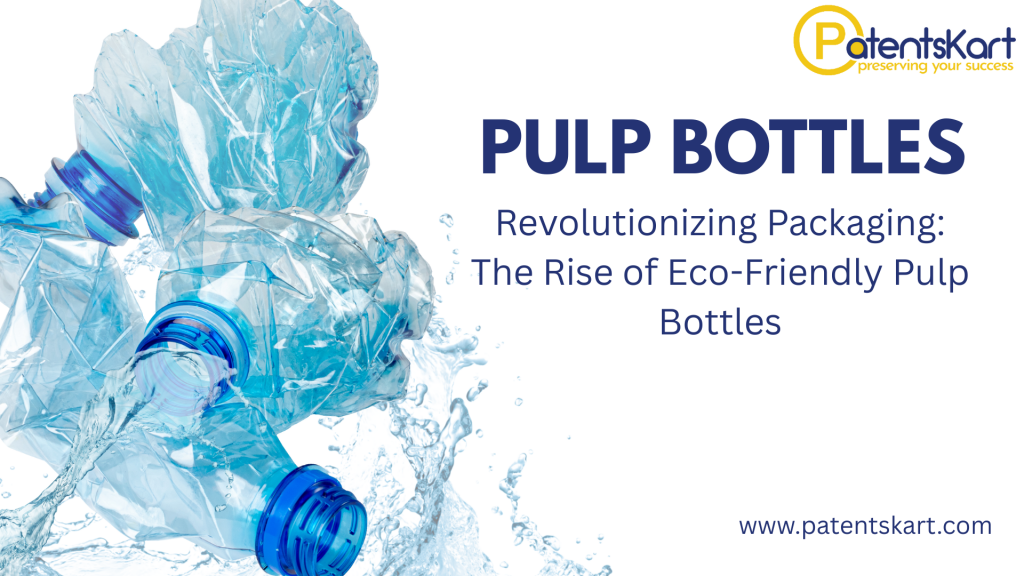What Is Pulp Bottles Technology?
Pulp bottles technology refers to the manufacturing of bottles using biodegradable materials such as molded fiber, recycled paper, bamboo, or agricultural waste. These pulp-based bottles serve as a sustainable alternative to conventional plastic and glass packaging. They are designed with the help of advanced molding techniques and are coated with bio-based or compostable barrier layers to preserve the contents.
This innovation aligns with growing global efforts to reduce single-use plastics and shift toward renewable, low-impact packaging materials. As brands across sectors—from food to cosmetics—seek eco-friendly solutions, pulp bottles technology has emerged as a scalable and impactful option.
How Are Pulp Bottles Made?
Pulp bottles are produced through a series of steps involving fiber molding, drying, and barrier coating. The process includes:
- Fiber Preparation: Agricultural waste or recycled paper is broken down into pulp using water and mechanical agitation.
- Molding: The wet pulp is shaped into bottle forms using specialized molds and vacuum forming.
- Pressing and Drying: Excess water is removed, and the molded bottle is heated and pressed for durability.
- Barrier Coating: A bio-based layer is applied to enhance water resistance, oil protection, and oxygen barrier properties.
- Finishing: Bottles may be printed or embossed for branding purposes and subjected to quality checks.
Unlike PET or glass production, pulp bottles require significantly less energy and generate fewer greenhouse gas emissions.
Why Is Pulp Bottles Technology Better Than Plastic?
The key benefits of pulp bottles technology over traditional plastic packaging include:
- Biodegradability: Pulp bottles decompose within 60 to 180 days in composting environments, leaving no microplastic residue.
- Renewable Raw Materials: Made from plant-based waste or recycled paper, reducing dependency on fossil fuels.
- Circular Economy Compliance: Enables cradle-to-cradle lifecycle management, aligning with zero-waste goals.
- Consumer Appeal: Meets growing demand for sustainable packaging, especially in premium and health-conscious markets.
- Lower Carbon Footprint: Lifecycle emissions are significantly lower than those of plastic or aluminum bottles.
The environmental and regulatory pressures facing plastics have created a market environment ripe for adoption of pulp bottles.
Where Are Pulp Bottles Being Used Today?
Pulp bottles technology is being implemented across various industries:
Food and Beverages
Pulp bottles are used for packaging still and sparkling water, cold brews, smoothies, plant-based milk, and sauces. Companies like Frugalpac and Paboco have launched commercial-grade fiber bottles for wine and spirits.
Personal Care and Cosmetics
Brands are adopting paper-based bottles for items such as shampoos, conditioners, lotions, and creams. These pulp-based containers offer aesthetic appeal along with functional protection.
Household Products
Molded fiber bottles are also used for detergents, refills, and cleaning agents, replacing HDPE or PET bottles with a greener alternative.
E-Commerce and Hospitality
Airlines, hotels, and e-commerce companies are using pulp bottles and molded packaging to reduce plastic usage in disposable amenity kits and shipped products.
Pulp bottles technology supports scalable manufacturing, custom branding, and smart packaging integration like QR codes and NFC tags.
Who Are the Leading Companies in Pulp Bottles Technology?
A number of industry leaders and startups are pushing the boundaries of pulp bottles technology:
Established Corporations
- Paboco: Backed by Coca-Cola, L’Oréal, and The Absolut Company, offering scalable pulp bottle production.
- Pulpex: Partnering with Unilever, PepsiCo, and Diageo to produce paper-based alternatives to plastic bottles.
- Stora Enso: Pioneering fiber-based bottle innovations, especially for carbonated drinks.
- Frugalpac: Known for its Frugal Bottle, used by wineries across Europe.
Innovative Startups
- Notpla: Creates seaweed-based and compostable coatings for molded fiber bottles.
- Paper Water Bottle: Offers compostable packaging made from wheat straw and bamboo pulp.
- Lactips: Develops water-resistant coatings derived from casein protein.
These companies have achieved commercial-scale readiness and are investing in international expansion, signaling long-term viability.
What Global Standards Govern Pulp Bottles Technology?
To ensure environmental safety and product performance, pulp bottles technology must meet several international standards. The table below outlines key regulatory benchmarks:
| Standard | Purpose | Applies To |
|---|---|---|
| ASTM D6400 | Specifies compostability of plastics | Barrier coatings, bottle linings |
| ASTM D6868 | Compostable packaging certification with coatings | Pulp bottle + coating combinations |
| ISO 17088:2021 | Standards for biodegradable plastic materials | Coating materials |
| ISO 22404:2019 | Aerobic biodegradation performance testing | Bottles and coatings |
| TÜV OK Compost | Certification for industrial and home compostability | Whole pulp bottles |
| ISO 14021:2016 | Environmental marketing and labelling | Claims on bottles and branding |
Understanding and adhering to these standards is essential for companies looking to enter regulated markets or seek eco-label certifications.
What Is the Future of Pulp Bottles Technology?
The market outlook for pulp bottles technology is promising. Adoption is expected to increase across industries as:
- Governments implement plastic bans and mandate compostable packaging.
- Consumers demand visible environmental action from brands.
- Brands invest in closed-loop packaging systems and net-zero initiatives.
Short-Term (1–3 Years)
- Pilot projects in FMCG and beverage sectors
- Increased investment in pulp molding facilities
- Adoption of bio-based coating technologies
Medium-Term (3–7 Years)
- Mainstream use in beauty, cleaning, and food packaging
- Global standardization for biodegradable packaging
- Emergence of smart pulp bottles with IoT tracking
Long-Term (Beyond 7 Years)
- Full market replacement of PET and HDPE bottles in specific segments
- On-site pulp molding in circular factories
- Integration into smart supply chains and zero-waste logistics
FAQ
What is pulp bottles technology and how does it work?
Pulp bottles technology involves creating bottles from molded fiber materials like recycled paper, bamboo, or sugarcane bagasse. The pulp is shaped using molds, dried, and coated with bio-based barriers to hold liquids or semi-solids. These bottles are compostable and serve as an eco-friendly alternative to plastic packaging.
Are pulp bottles biodegradable and safe for food packaging?
Yes, pulp bottles are fully biodegradable and can be made food-safe through the use of plant-based or biodegradable barrier coatings. Many pulp bottles comply with international food safety and compostability standards such as ASTM D6400, ISO 17088, and TÜV OK Compost.
Which industries are using pulp bottles technology today?
Pulp bottles are being used in the beverage industry (juices, water, alcohol), personal care (shampoos, lotions), household products (detergents), and even e-commerce and hospitality sectors. Major brands like Coca-Cola, Unilever, and L’Oréal have piloted or adopted this packaging innovation.
How do pulp bottles compare to plastic or glass bottles?
Pulp bottles offer significant environmental advantages over plastic and glass. They are lighter, compostable, made from renewable materials, and have a lower carbon footprint. While glass and plastic may offer longer shelf-life, pulp bottles are ideal for short to medium-term use cases and are more sustainable.
What companies are leading innovation in pulp bottles technology?
Some of the top companies innovating in pulp bottles technology include Paboco, Pulpex, Stora Enso, Frugalpac, Notpla, and Paper Water Bottle. These companies are partnering with global brands to replace single-use plastic packaging with fiber-based alternatives.
How Can PatentsKart Help You Adopt Pulp Bottles Technology?
PatentsKart offers specialized services to companies seeking to innovate in the sustainable packaging space using pulp bottles technology. Our services include:
Technology Scouting
Identify the most valuable patents, innovations, and startup activities related to pulp bottles, biodegradable materials, and barrier coatings.
IP Strategy Development
Secure your intellectual property rights and align your pulp packaging solutions with global compliance and innovation benchmarks.
Competitive Intelligence
Monitor your industry rivals and benchmark your pulp bottle R&D efforts against global leaders like Paboco, Pulpex, and Notpla.
Licensing and Partnerships
Find and negotiate technology acquisition or licensing deals to fast-track your market entry.
Custom Landscape Reports
Gain access to in-depth technical and strategic reports like the one this blog is based on, tailored for your sector.
Explore More Insights from PatentsKart
Looking for more innovation in sustainability, materials science, and green technology? Check out our recent blogs:
- Smart Rings in Healthcare: The Next Frontier
- CO₂ Conversion into Chemicals: Green Chemistry in Action
- Fabric Care Technology: Patents Driving Innovation in 2025
- Green Chemicals and Pet Wellness Innovation
These reports are packed with actionable insights and patent-driven innovation strategies.
Conclusion: Is Pulp Bottles Technology Worth the Investment?
Pulp bottles technology represents a pivotal opportunity for brands to future-proof their packaging strategy. It addresses global concerns around plastic waste, appeals to environmentally aware consumers, and meets emerging compliance requirements. With scalable production, smart packaging potential, and ongoing investment by global leaders, the technology is well-positioned to redefine sustainable packaging.
If you are exploring innovation in biodegradable packaging or looking to lead in sustainability, investing in pulp bottles technology is not just timely—it’s essential.
Check out our website: www.patentskart.com
Or contact us at: info@patentskart.com







